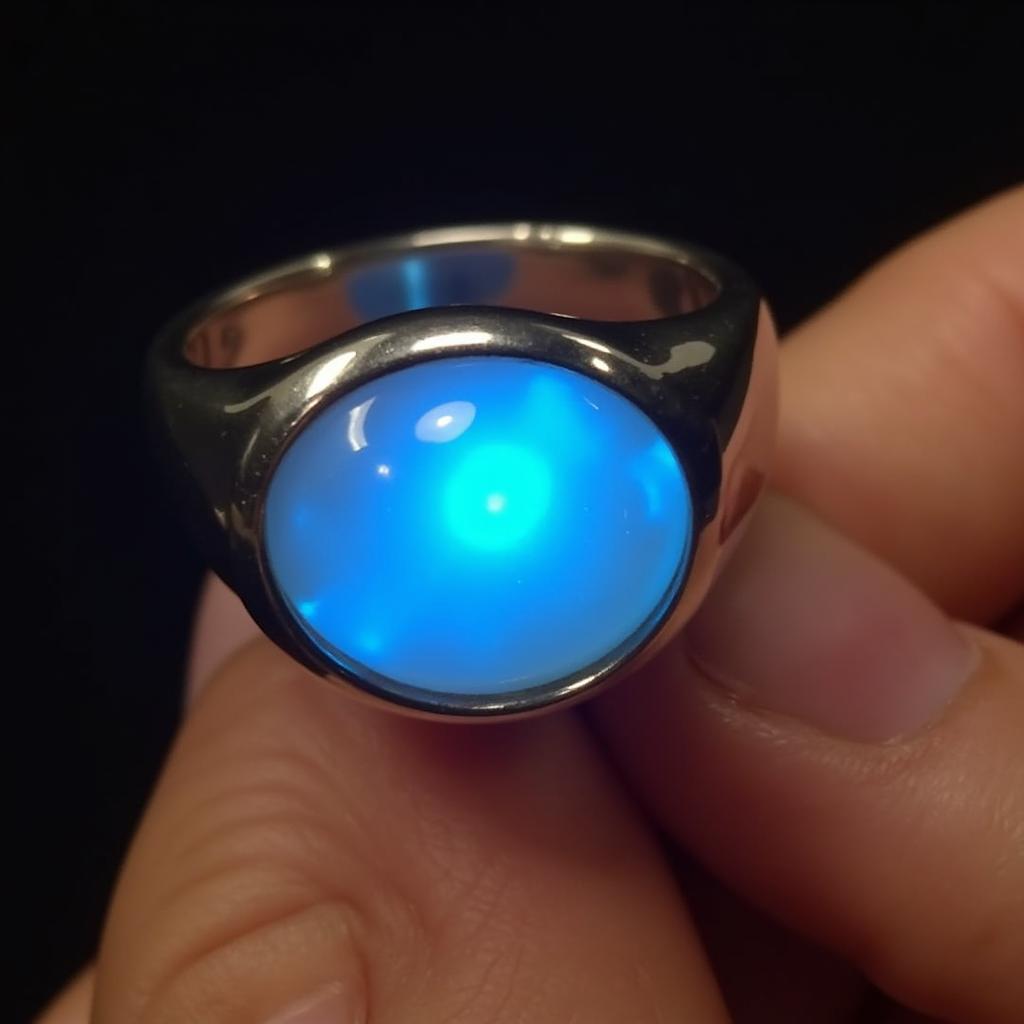Mood rings have been captivating imaginations since the 1970s with their supposed ability to reflect the wearer’s emotional state through changing colors. While their accuracy as mood detectors is debatable, these playful pieces of jewelry continue to spark curiosity. Among the array of colors a mood ring can display, blue often holds a special significance. So, What Does The Color Blue Mean On A Mood Ring?
Let’s dive into the world of mood ring colors and explore the various interpretations associated with the color blue.
Decoding the Blue Hue on a Mood Ring
Mood rings typically contain liquid crystals that are sensitive to temperature changes. As your body temperature fluctuates, so does the color of the ring. While not an exact science, the color blue on a mood ring is generally associated with calmness, serenity, and peace.
Here’s a breakdown of common interpretations for the color blue on a mood ring:
- Dark Blue: Often associated with deep relaxation, contentment, or a meditative state. It can also signify feelings of love, trust, and harmony.
- Light Blue: Suggests a more gentle and tranquil mood. It can indicate a state of calmness, serenity, or a clear mind.
- Turquoise Blue: This vibrant shade of blue often represents communication and creativity. It can signify a time of inspiration, self-expression, and open communication.
 Mood ring displaying a vibrant blue color
Mood ring displaying a vibrant blue color
Mood Ring Colors: A Spectrum of Emotions
It’s important to note that the meaning of colors on a mood ring can be subjective and vary depending on individual interpretations and cultural backgrounds. However, here’s a general guide to other colors you might encounter on a mood ring and their common associations:
- Green: Represents a balanced emotional state, tranquility, and harmony.
- Yellow: Indicates happiness, optimism, and creativity.
- Amber: Suggests a warm, energetic, and active mood.
- Orange: Symbolizes excitement, enthusiasm, and passion.
- Red/Brown: Can indicate strong emotions like anger, stress, or anxiety.
- Black/Gray: Often associated with coldness, sadness, or a lack of energy.
The Science (or Lack Thereof) Behind Mood Rings
While mood rings can be a fun accessory, it’s essential to understand that their ability to accurately reflect emotions is not scientifically proven. The color changes are primarily driven by fluctuations in skin temperature, which can be influenced by various factors beyond emotions, such as:
- Ambient Temperature: Cold weather can cause the ring to turn darker, while warm weather can make it appear brighter.
- Physical Activity: Exercise and increased blood flow can affect skin temperature and alter the ring’s color.
- Overall Health: Illness or fever can also cause noticeable changes in body temperature and ring color.
Mood Rings: Fun Fashion or Emotional Barometer?
While mood rings might not be the most reliable tool for gauging emotions, they can still be a fun and engaging accessory. Their ever-changing colors spark conversations, evoke nostalgia, and serve as a playful reminder of the dynamic nature of our feelings.
The next time you see someone sporting a mood ring, particularly one glowing with the serene hue of blue, remember that it might simply reflect their relaxed state rather than a deep dive into their emotional depths.
Frequently Asked Questions about Mood Rings
1. How accurate are mood rings at detecting emotions?
Mood rings are not scientifically proven to accurately detect emotions. Color changes are primarily driven by variations in skin temperature, which can be influenced by numerous factors beyond emotional state.
2. What does a purple mood ring mean?
While not always present on a standard mood ring color chart, purple is sometimes associated with passion, romance, or a deep connection with one’s intuition.
3. Can I wear a mood ring all the time?
Mood rings are generally considered safe to wear for extended periods. However, it’s advisable to remove them occasionally to allow your skin to breathe and prevent any potential irritation.
what does the mood ring colors mean
4. How do I know if my mood ring is working correctly?
If your mood ring changes color in response to noticeable temperature variations, it’s likely functioning as intended. Keep in mind that these changes primarily reflect skin temperature rather than emotions.
5. Where can I buy a mood ring?
Mood rings are readily available online, at novelty shops, and in some jewelry stores.
what does the color blue mean in a mood ring
For any support, you can contact us through our hotline: 0373298888, email us at [email protected] or visit our address at 86 Cầu Giấy, Hà Nội. We have a 24/7 customer service team to support you.